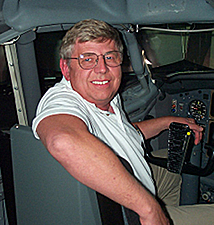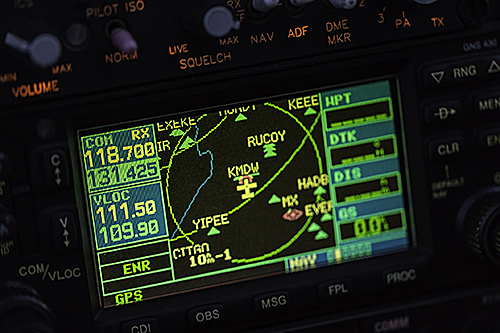“Oxygen, Avionics and Other Safety Tips”
By Capt. Michael J. “Mick” Kaufman
BPT Program Manager/Flight Operations
In my last writing of the “Captain’s Corner”, the emphasis was placed on the pilot’s ability to hand fly a precision approach in turbulent conditions with close tolerances.
I recently flew my Bonanza from Wisconsin to California for a BPT training program and with every trip or adventure, there is a learning experience even for an old veteran aviator. It has been several years since I did any high altitude flying, and the IFR minimum en-route altitudes for this trip were in the mid-teens.
A few days before departure, it was time to get those oxygen cylinders out of storage and dust them off. Both of my tanks had been in storage for years and in checking, they were less than ¼ full. There being time to get the cylinders filled, I found that the place that had filled them last was out of business. Let’s try the pharmacy. They did not fill tanks but exchanged the empty ones with full tanks. They told me that I needed a prescription from a physician to get oxygen! It seems a bit ridiculous, but thanks to some doctor friends, I got it done.
Several years back I acquired an oxygen regulator that sensed the breathing of the pilot and would conserve oxygen usage. Making the bad assumption that it would be just a matter of mating the regulator on the tank and installing a battery, everything would work great. So, I waited until the day before departure to set it up, and it did not work. With no time to troubleshoot the problem, I took my old oxygen regulator out and put it on the tank assuming it had worked before, so no need to test it.
On the flight as the MEA got to the point that my copilot and I needed oxygen, we found that the regulator had gone bad. My copilot was able to adjust the output, so we were able to get oxygen for the MEA’s that required oxygen for the trip to California. I purchased a new regulator in California, so the trip home went without incident.
I have always been a fan of having current weather information in the cockpit and since my first aviation weather receiver, a Garmin 396 portable, I have been a fan of Sirius XM weather. In my last avionics update, I had a Garmin GDL 52 weather receiver installed. It is unique in that it not only provides Sirius XM weather and radio but ADSB weather and traffic as well.
The trip to California from Wisconsin had one fuel stop in Albuquerque, which was during the annual balloon festival. It was a great experience with a perfect launch morning and with many amazing balloon shapes. After seeing the morning balloon launch, the weather check showed that a line of thunderstorms had developed along our intended route to California.
Sirius XM weather really paid off the entire year’s subscription on that leg. Not only does Sirius XM weather offer faster updates and better resolution, it can also be used in those areas that have poor or no ADSB coverage due to terrain as we experienced. Remember ADSB weather does not come from aircraft transponders or ADSB transmitters in aircraft which provides traffic, but from ground-based stations often obstructed by terrain.
With the upsurge in technology that has filtered to avionics, many of the pilots attending BPT flight clinics are there to learn how to use their newly installed avionics. Fresno, CA was no exception – and as program manager for BPT, I work hard to honor the requests of our pilot participants by matching their equipment to an instructor who is familiar with it.
Several decades ago, we all navigated with VOR and ADF, and it did not make any difference who the manufacturer of the equipment was: they all worked the same. Not so today, and it creates issues in flight training, so I work hard to assign instructors that are the most familiar with their equipment to pilot customers.
More than a decade ago Garmin introduced the 430/530 series of avionics, which had no WAAS. As an instructor at the time, I got to fly the first WAAS box at one of our flight clinics, a UPS Technologies CNX-80 later to be purchased by Garmin and become the Garmin 480. I could not make this box do an approach, and I had egg all over my face. I took this noble experience as a challenge and learned the ins and outs of this box to become the go-to-guy on this navigator for pilot customers with this box in their airplanes. Today, I have a decade-old Garmin 480 in my own airplane, which was also a decade ahead of other navigators.
As mentioned above, I try to pair BPT instructors with pilot customers based on the aircraft and the avionics equipment. Some of these matches surprise the pilot customers who find out from the instructor that there were errors made by the avionics install shop either in wiring or programming.
This was the case at the Fresno flight clinic with one of our pilot customers. I have seen installation and programming errors more times than I can remember. Some of these situations can catch an unsuspecting pilot off guard and can even lead to a fatality.
The mating of a Garmin 430/530 box with a KFC-150 autopilot with altitude pre-select can cause the aircraft to pitch up and stall when the glideslope becomes active. There was a firmware update to fix this issue, but that had not been done in this customer’s aircraft. Because of his training, he is now aware of what could be a dangerous situation until he gets an avionics firmware update.
Another avionics issue produced a situation where the autopilot cannot capture a glideslope on the ILS but can on a GPS approach. This situation is still being investigated by the instructor with a hopeful solution soon.
BPT is dedicated to flight training and making safer pilots as well as helping pilots in getting to know their equipment and correct installation and programming issues. I hope to see you at a future BPT training clinic. Please let me know any special requests you may have when signing up for one of our training programs.
Be safe,
Michael J. “Mick” Kaufman
817-988-0174





